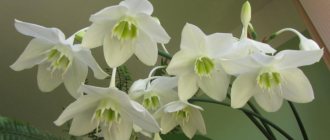Author: Elena N. https://floristics.info/ru/index.php?option=com_contact&view=contact&id=19 Category: Garden plants Published: June 23, 2018Last edits: January 20, 2021
- Growing conditions
- Golden lycoris (Lycoris aurea)
Licorice (lat. Lycoris) is a genus of flowering perennials of the Amalliaceae family, consisting of more than 20 species. Representatives of the genus come from East and South Asia: Japan, Thailand, Laos, South Korea, Nepal, Pakistan, eastern Iran and southern China. Some species were introduced to Texas, North Carolina and other American states, and some of them became naturalized in the new conditions. In English-speaking countries, the lycoris flower is called hurricane or spider lily. In floriculture literature you can find the Japanese name for lycoris - “higanbana”. The plant also has another name - the flower of death: lycoris is traditionally planted in cemeteries.
Planting and caring for lycoris
- Flowering: for two weeks in September-October.
- Planting: bulbs are planted in the ground before winter - in September-October.
- Lighting: partial shade.
- Soil: sandy, fertilized.
- Watering: during the period of active growth - regular, after flowering is completed, watering is stopped.
- Fertilizing: not necessary, but the plant responds well to mineral complexes for bulbous crops.
- Reproduction: most often - by daughter bulbs, less often - by seeds.
- Pests: daffodil flies.
- Diseases: bulb rot.
Read more about growing lycoris below.
Pests
Despite our howling beauty, this plant is poisonous. Therefore, it is often planted in plots. To protect it from pests. In particular, in China it is planted near rice fields, this helps preserve the harvest.
However, insects can also harm poisonous bushes. In the case of this plant, it is, first of all, the narcissus fly. But the use of systemic fertilizers (insecticides) allows you to protect yourself from it.
You should not overwater the bush, as this can destroy the root system - it will rot. You should not plant it in direct sunlight. This will damage the leaves and flowers, and light spots (burns) will appear on them.
Botanical description
Lycoris leaves reach a length of 30 to 60 cm and a width of only 5-20 mm. The stem of lycoris is erect, from 30 to 90 cm in height. One plant can produce up to 7 peduncles with fragrant flowers of red, orange, yellow, golden, purple or white. Lycoris has two types of flowers: in one type the stamens are several times longer than the perianth, in the second they rise only slightly above the petals. The fruit of lycoris is a three-channel capsule with seeds. Many species of the genus are sterile and reproduce only vegetatively.
In the photo: Blooming garden lycoris
Lycoris has one biological oddity: the flowers and leaves of the plant never meet each other. When does lycoris bloom? In the summer, lycoris bulbs rest in the soil; in early September they shoot out flower stalks that rapidly gain height: in 4-5 days the shoots can grow to 50 centimeters or more. Each peduncle bears 4-5 lily-like funnel-shaped flowers with a large number of stamens, which is why the flowers resemble spiders. Lycoris blooms for up to two weeks, then the flowers fade, and only after that the plant begins to form arrow-shaped leaves, which persist throughout the winter and die in early summer.
Transfer
Every 2-3 years it is necessary to plant the bulbs. The time for transplantation is selected depending on the variety.
Autumn-blooming crocus varieties should be dug up in June. Spring flowering plants are replanted in September.
After digging, the bulbs are dried and cleaned of defective scales. Dead roots are cut off, and diseased bulbs must be disposed of without regret. Any mechanical damage is treated with a small amount of crushed coal.
Important! Before planting in the ground, it is necessary to move the planting material to the basement. It is advisable to dig up crocuses after flowering.
Planting lycoris in open ground
When to plant
It is best to plant lycoris in the fall, a month before the onset of cold weather, so that the bulbs have time to adapt to the soil and grow roots. If necessary, you can plant the bulbs in the ground in the spring, but the plants will almost certainly get sick. In any case, you shouldn’t expect the capricious spider lily to bloom next year.
- Liviston at home: care and types
In the photo: White lycoris blooming in the garden
In order for the cultivation of lycoris to be successful, you need to choose the right place for it and create conditions as close as possible to natural ones. Areas protected from wind and drafts in the partial shade of large deciduous trees are suitable for lycoris.
How to plant
Lycoris grows best in sandy soils. Before planting, clear the area of weeds, dig it up, if necessary, with peat, sand and humus and level the surface.
Large lycoris bulbs, covered with dark brown scales, are buried at least 14 cm so that they do not freeze in frosts. The distance between the holes should be 25-30 cm: every year the bulbs are overgrown with children, each of which needs a certain feeding area. You need to lay a layer of sand in the hole, lightly press the onion into it, fill it to the top with sand, and fill the remaining space with soil. After planting, the surface of the area is compacted and watered abundantly.
Meaning of lily tattoos
Dracaena palm tree: cultivation and care at home, types with photos and descriptions
The meaning of this exotic flower has much in common with the symbolism of the lotus. For girls, it is the personification of nobility, spiritual harmony, tranquility, hope, innocence and greatness, glory. The Royal Lily is a symbol of endless love, devotion and fidelity to one’s chosen one. Female representatives often prefer the royal or fleur-de-lis. Previously, such a plant adorned the coats of arms of French monarchs. The heraldic lily is one of the varieties of this popular ornament. It doesn't look like a real flower at all. Typically, this design is chosen by women who want to emphasize their noble origin and high financial status.
A stem with several flowers is a symbol of immortality, and such a tattoo will bring wealth, health, and success to its owner.
The lily did not always have a positive meaning. Previously, such a flower was a mark of women of easy virtue. And in places of detention, such an ornament was made by gay women.
What does tiger lily mean? This is a symbol of originality and independence; this type of ornament is chosen by creative individuals.
The water lily is a water lily, since ancient times it has been considered a symbol of purity, innocence, purity and beauty. Many people believe that such a tattoo makes their cherished desires come true, because a water lily appears from a star that fell from the sky.
There is another type of tattoo - the spider lily, “cutting demons.” According to ancient legends, it protected its owner from evil forces.
When applying a design to a body, its color matters. The white lily, just like the rose, is considered the queen of flowers. A delicate pink bud emphasizes the romantic nature of its owner.
Experts in the world of tattoos recommend that passionate women with a strong character give preference to open buds in dark colors. A black lily will indicate the girl’s temperament and passion.
Caring for lycoris in the garden
Growing conditions
Planting lycoris and caring for this exotic plant in open ground will not require much effort. You will have to perform a few simple manipulations: water the plant, loosen the soil around it, remove weeds, apply fertilizer and prepare the lycoris for winter. From time to time you have to replant the plant and destroy the pests attacking it.
In the photo: Growing lycoris in the garden
Watering and fertilizing
Lycoris especially needs watering during the period of active growth of peduncles and leaves. At this time, the soil on the site should be regularly moistened, preventing the soil from drying out. The soil should be slightly moist at all times. When lycoris goes dormant, and the plant rests not only in summer, but also in winter, stop watering the soil.
Applying fertilizers to the area with lycoris is not a necessary procedure: if your lily looks healthy and beautiful, it means it has enough nutrition. But if you notice some lethargy or depression of lycoris, add mineral fertilizers for bulbous crops to the soil.
- Growing godetia seedlings: sowing and picking
Features of growing eucharis at home
Transfer
Lycoris does not require annual replanting, like many bulbous plants; it can grow in one area for up to 5 years, but then the bulbs still need to be dug up, divided and replanted.
First prepare a new area for lycoris, then dig up the bulbs, carefully separate the children from them, sprinkle the broken areas with coal powder or ash and plant the planting material in a new place, following the order we have already described. If transplantation is carried out in the fall, the area is not watered. Keep in mind that lycoris may not bloom for one to two years after transplanting. Do not divide the plant too often: this will weaken it. All parts of lycoris are poisonous, so wear gloves.
In the photo: How to grow lycoris from bulbs
Reproduction
Most often, lycoris is propagated vegetatively, that is, by daughter bulbs, since lycoris seeds are difficult to obtain: many plant species simply do not produce them. The method of reproduction by children is simple to implement, and we have just described it to you.
How to plant and care for hippeastrum
Lycoris after flowering
After the lycoris flowers fade, its leaves begin to form. At the end of autumn, the dry parts of the plant should be removed, but there is no need to dig up the bulbs for the winter: they take deep roots and are not afraid of even severe frosts. If a cold, snowless winter is expected, cover the area with a layer of dry leaves or spruce branches. With the onset of spring, the shelter can be removed.
Reproduction
Lycoris is rarely propagated by seeds, since only a few species produce productive seeds. Most often, the vegetative method is used for propagation.
Each year the plant grows several daughter bulbs. At the end of the season, the babies are ready for independent growth and can be separated.
However, the plant cannot be divided often, as it weakens and may not bloom for a couple of years.
- After flowering, dig up the bulb;
- Carefully separate them from each other;
- After separation, plant the daughter bulb in a new place, and plant the mother bulb back.
Types and varieties
There are not many species of lycoris grown in cultivation, and we will introduce you to some of the most commonly found plants of this genus in gardens.
Golden lycoris (Lycoris aurea)
This species comes from Japan and China and can withstand frosts only down to -5 ºC, and therefore in the middle zone it is better to grow it as an indoor crop. The plant reaches a height of 60 cm, and a diameter of about 20 cm. Tubular bright yellow flowers of golden lycoris with a diameter of up to 10 cm bloom in late spring or early summer and form an inflorescence of 5-6 pieces.
- Nigella: growing from seeds, types and varieties
In the photo: Golden lycoris (Lycoris aurea)
Lycoris squamigera
It comes from Japan and reaches a height of 60-70 cm. It has belt-shaped, broad-linear basal leaves, which appear after the fragrant funnel-shaped lilac-pink flowers with a yellow center and bent perianth lobes, collected in a bunch of 6-8 pieces, have faded. This species does not produce seeds, so it is propagated by daughter bulbs.
In the photo: Lycoris squamigera
Lycoris radiata
It is found naturally in Nepal, Korea and China; it is also naturalized in the USA, Japan and other countries. Lycoris radiata is a perennial that produces flowers before leaves. The height of the flower arrows of Lycoris radiata can reach from 30 to 70 cm. Long leaves located parallel to each other, no more than 1 cm wide, sometimes bend from the middle of the plate. Irregularly shaped flowers have side petals that resemble long and thin tendrils leaning back, and in their center there is a bunch of short and wide petals of an arched wavy shape.
In the photo: Lycoris radiata
Blood red lycoris (Lycoris sanguinea)
This is a compact species, reaching a height of 45 cm. This lycoris produces tiny leaves in April that die in June, and the plant blooms in August with bright scarlet flowers about 5 cm in diameter.
In the photo: Blood red lycoris (Lycoris sanguinea)
Usage
In the east, lycoris is rarely used to decorate gardens. This is associated with legends and superstitions. Residents of the Middle Kingdom consider lycoris to be a symbol of misfortune. Allegedly, flowers grow on battlefields where blood has been shed. Therefore, they are often planted in cemeteries. In our country, this beautiful flower is planted with pleasure and without any consequences in flower beds, mixborders and rock gardens. They take root well in the sparse shade of trees.
Article on the topic: Spiraea gray Grefsheim: description of varieties with photos, planting and care, pruning, propagation
In early spring, lush greenery hides the bare soil, and in late summer the ground is painted with crimson flowers. The best neighbors for the plant are hostas, begonias, crocuses, anemones, ferns and liriope.
Legend of the Flower of Death
Lycoris is the European name of an oriental plant, derived from the name of the beautiful Nereid (sea nymph). According to Asian legend, the flower was looked after by the spirits of the plant world Manzhu and Saga. The first was responsible for the flowers, the second for the leaves. One day they forgot about their assigned work for the sake of meeting each other. God chose a cruel punishment for the lovers: to seem to be close, but not to be able to see each other. During the flowering period of lycoris, the leaves dry out, and when they appear again, the flowers are no longer there.
In Japanese culture, special significance is given to the bright red variety of lycoris.
The Japanese usually plant this flower in the cemetery and use it in mourning ceremonies, because they believe that it grows at the edge of the underground roads of death. Other plant names:
- manjusaga (in honor of spirits in love);
- higanban (meaning: “autumn equinox flower”);
- heavenly flower;
- ghost flower;
- fox flower;
- demon lily;
- spider lily;
- flower of the dead;
- desert Flower;
- razor flower;
- hell flower;
- flower of death.











